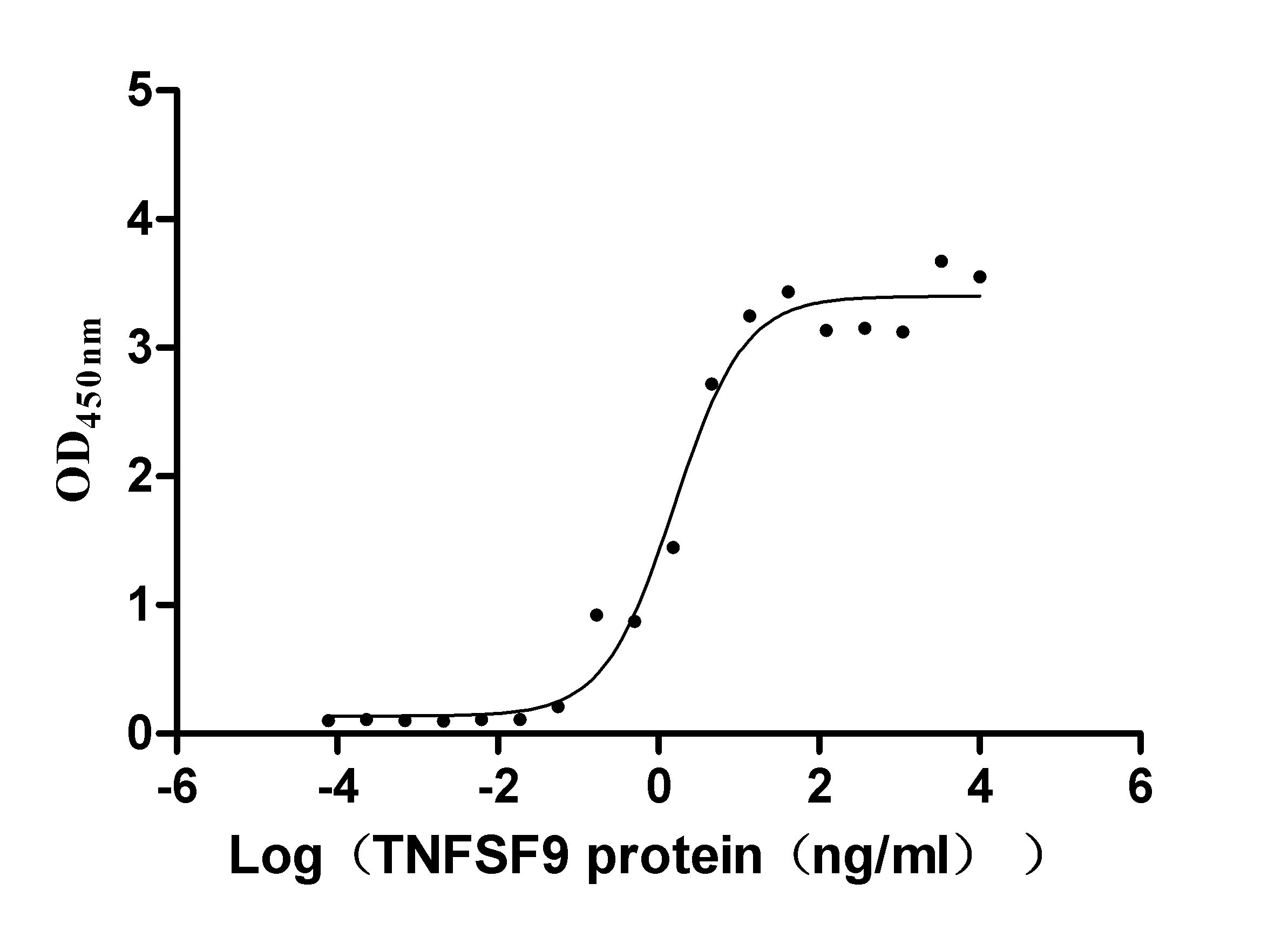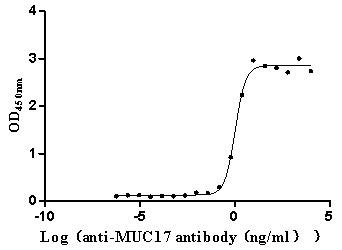Recombinant Arabidopsis thaliana Ethylene-responsive transcription factor ABI4 (ABI4)
-
中文名称:Recombinant Arabidopsis thaliana Ethylene-responsive transcription factor ABI4(ABI4),Yeast
-
货号:CSB-YP370645DOA
-
规格:
-
来源:Yeast
-
其他:
-
中文名称:Recombinant Arabidopsis thaliana Ethylene-responsive transcription factor ABI4(ABI4),Yeast
-
货号:CSB-EP370645DOA
-
规格:
-
来源:E.coli
-
其他:
-
中文名称:Recombinant Arabidopsis thaliana Ethylene-responsive transcription factor ABI4(ABI4),Yeast
-
货号:CSB-EP370645DOA-B
-
规格:
-
来源:E.coli
-
共轭:Avi-tag Biotinylated
E. coli biotin ligase (BirA) is highly specific in covalently attaching biotin to the 15 amino acid AviTag peptide. This recombinant protein was biotinylated in vivo by AviTag-BirA technology, which method is BriA catalyzes amide linkage between the biotin and the specific lysine of the AviTag.
-
其他:
-
中文名称:Recombinant Arabidopsis thaliana Ethylene-responsive transcription factor ABI4(ABI4),Yeast
-
货号:CSB-BP370645DOA
-
规格:
-
来源:Baculovirus
-
其他:
-
中文名称:Recombinant Arabidopsis thaliana Ethylene-responsive transcription factor ABI4(ABI4),Yeast
-
货号:CSB-MP370645DOA
-
规格:
-
来源:Mammalian cell
-
其他:
产品详情
-
纯度:>85% (SDS-PAGE)
-
基因名:ABI4
-
Uniprot No.:
-
别名:ABI4; ERF052; GIN6; ISI3; SAN5; SIS5; SUN6; At2g40220; T7M7.16Ethylene-responsive transcription factor ABI4; ERF ABI4; Protein ABSCISIC ACID INSENSITIVE 4; Protein GLUCOSE INSENSITIVE 6; Protein IMPAIRED SUCROSE INDUCTION 3; Protein SALOBRENO 5; Protein SUCROSE UNCOUPLED 6; Protein SUGAR INSENSITIVE 5
-
种属:Arabidopsis thaliana (Mouse-ear cress)
-
蛋白长度:full length protein
-
表达区域:1-328
-
氨基酸序列MDPLASQHQH NHLEDNNQTL THNNPQSDST TDSSTSSAQR KRKGKGGPDN SKFRYRGVRQ RSWGKWVAEI REPRKRTRKW LGTFATAEDA ARAYDRAAVY LYGSRAQLNL TPSSPSSVSS SSSSVSAASS PSTSSSSTQT LRPLLPRPAA ATVGGGANFG PYGIPFNNNI FLNGGTSMLC PSYGFFPQQQ QQQNQMVQMG QFQHQQYQNL HSNTNNNKIS DIELTDVPVT NSTSFHHEVA LGQEQGGSGC NNNSSMEDLN SLAGSVGSSL SITHPPPLVD PVCSMGLDPG YMVGDGSSTI WPFGGEEEYS HNWGSIWDFI DPILGEFY
-
蛋白标签:Tag type will be determined during the manufacturing process.
The tag type will be determined during production process. If you have specified tag type, please tell us and we will develop the specified tag preferentially. -
产品提供形式:Lyophilized powder
Note: We will preferentially ship the format that we have in stock, however, if you have any special requirement for the format, please remark your requirement when placing the order, we will prepare according to your demand. -
复溶:We recommend that this vial be briefly centrifuged prior to opening to bring the contents to the bottom. Please reconstitute protein in deionized sterile water to a concentration of 0.1-1.0 mg/mL.We recommend to add 5-50% of glycerol (final concentration) and aliquot for long-term storage at -20℃/-80℃. Our default final concentration of glycerol is 50%. Customers could use it as reference.
-
储存条件:Store at -20°C/-80°C upon receipt, aliquoting is necessary for mutiple use. Avoid repeated freeze-thaw cycles.
-
保质期:The shelf life is related to many factors, storage state, buffer ingredients, storage temperature and the stability of the protein itself.
Generally, the shelf life of liquid form is 6 months at -20°C/-80°C. The shelf life of lyophilized form is 12 months at -20°C/-80°C. -
货期:Delivery time may differ from different purchasing way or location, please kindly consult your local distributors for specific delivery time.Note: All of our proteins are default shipped with normal blue ice packs, if you request to ship with dry ice, please communicate with us in advance and extra fees will be charged.
-
注意事项:Repeated freezing and thawing is not recommended. Store working aliquots at 4°C for up to one week.
-
Datasheet :Please contact us to get it.
靶点详情
-
功能:Transcription regulator that probably binds to the GCC-box pathogenesis-related promoter element. Binds also to the S-box (5'-CACTTCCA-3') photosynthesis-associated nuclear genes-related (PhANGs-related) promoter element, and thus acts as a transcription inhibitor. Involved in the regulation of gene expression by stress factors and by components of stress signal transduction pathways. May have a function in the deetiolation process. Confers sensitivity to abscisic acid (ABA), and regulates the ABA signaling pathway during seed germination, upon nitrate-mediated lateral root inhibition, in hexokinase-dependent sugar responses (including feed-back regulation of photosynthesis and mobilization of storage lipid during germination), and in response to osmotic stress mediated by NaCl, KCl or mannitol. Plays a role in sucrose sensing or signaling, especially at low fluence far red light. Also involved in plant response to glucose treatment, especially at low concentration and in young seedlings. Required for the trehalose-mediated root inhibition and starch accumulation in cotyledons, probably by inhibiting starch breakdown. However, seems to not be involved in sugar-mediated senescence. Required for the ABA-dependent beta-amino-butyric acid (BABA) signaling pathway. BABA primes ABA synthesis and promotes resistance to drought and salt, and leads to a prime callose accumulation that confers resistance against necrotrophic pathogens such as A.brassicicola and P.cucumerina. Seems to be involved in resistance to S.sclerotiorum probably by regulating the ABA-mediated stomatal closure apparently by antagonistic interaction with oxalate. Negative regulator of low water potential-induced Pro accumulation whose effect is decreased by high levels of sugar.
-
基因功能参考文献:
- Compared to the wild-type (Col-0) Arabidopsis thaliana plants, the abi4 mutant demonstrated increased susceptibility to two-spotted spider mite, reflected as enhanced female fecundity and greater frequency of mite leaf damage after trypan blue staining. PMID: 29210003
- The photorespiratory phenotype of cat2-2 mutants did not depend on the SHR functional interactor SCARECROW and the sugar signaling component ABSCISIC ACID INSENSITIVE4, despite the requirement for exogenous sucrose for cell death attenuation in cat2-2 shr-6 double mutants. PMID: 27432873
- ABI4 plays a key role in abscisic acid and cytokinin signaling during eed germination and cotyledon greening.ABI4 suppresses the transcription of ARR6, ARR7 and ARR15 PMID: 27711992
- Molecular analysis showed that BPCs bind to the ABI4 promoter and repress ABI4 transcription in roots. PMID: 28138058
- ABA-INSENSITIVE 4 (ABI4) is a central factor in abscisic acid (ABA) and gibberellins (GAs) homeostasis and antagonism in post-germination stages. PMID: 26708041
- ABSCISIC ACID-INSENSITIVE 4 (ABI4), a key component in the abscisic acid signalling pathway, negatively regulates floral transition by directly promoting FLOWERING LOCUS C (FLC) transcription. ABI4-overexpressing plants had delayed floral transition. PMID: 26507894
- Disruption of RETARDED ROOT GROWTH-LIKE (RRL) decreased while overexpression increased ABA sensitivity during seed germination and seedling growth. ABI4 is a downstream regulatory factor in this RRL-mediated ABA signalling. PMID: 26163700
- MYB96-ABI4 module regulates lipid mobilization specifically in the embryo to ensure proper seed germination under suboptimal conditions. PMID: 25869652
- Chromatin immunoprecipitation-qPCR and transient expression analysis showed that ABI4 directly binds to the GSQ11/ANAC060 promoter to activate transcription. PMID: 24625790
- The degradation of ABI4 protein through the PEST motif is mediated by the 26S proteasome in response to changes in the sugar levels. PMID: 24046063
- The abi4, cbfA and cbp mutants showed weaker drought-tolerance after a herbicide norflurazon treatment, which indicated the physiological role of these key transcription factors. PMID: 23832569
- ABI4 downregulates expression of the sodium transporter HKT1;1 in Arabidopsis roots and affects salt tolerance. PMID: 23240817
- this study suggests that ABI4 is a key factor that regulates primary seed dormancy by mediating the balance between abscisic acid and gibberellins biogenesis. PMID: 23818868
- suppressor mutation causing the phenotype of soa1 occurred in the ABI4 (ABA insensitive 4) gene PMID: 23196831
- Low ascorbate triggers ABA- and jasmonate-dependent signaling pathways that together regulate growth through ABI4. PMID: 21926335
- ABI4 promoter activity during seedling development was followed, focusing on the roots. PMID: 21448003
- The study examined ABI4 protein accumulation indirectly, using transgenic lines expressing fusions to beta-glucuronidase. Inclusion of ABI4 coding sequence reduced the ratio of activity to transcript by ~150-fold when controlled by the ABI4 promoter. PMID: 21504878
- Data suggest that ABI4 mediates abscisic acid and cytokinin inhibition of lateral root formation via reduction of polar auxin transport and that the resulting decrease in root auxin leads to a reduction in lateral root development. PMID: 21097710
- Double-mutant analysis showed that ABA-insensitive 4 (ABI4) is epistatic to AtLPP2 but ABA-insensitive 3 (ABI3) is not. PMID: 15960620
- Impaired responses to light, sugars, and abscisic acid in ABI mutants of A. thaliana. PMID: 16098105
- ABI4 functions as a repressor of lipid breakdown. PMID: 16844907
- Study defines abscisic acid(ABA)-induced resistance to L. maculans as a subset of the ABA responses regulated via ABI-1 and ABI4. PMID: 17427804
- The abi4 phenotype of Arabidopsis expressing tomator ASR1 is the result of competition between the foreign ASR1 and the endogenous ABI4 on specific promoter DNA sequences. PMID: 18363631
- ABI4 binds directly to the promoter region of ABI5 and SBE2.2, and its own promoter, and activates expression in vivo through a CE1-like element. PMID: 19392689
- ABI4 plays a central role in mediating mitochondrial retrograde signals to induce the expression of AOX1a. PMID: 19482916
显示更多
收起更多
-
亚细胞定位:Nucleus.
-
蛋白家族:AP2/ERF transcription factor family, ERF subfamily
-
组织特异性:In seeds, mostly in embryo, and seedlings, especially in vascular tissues. Confined to the hypocotyl, cotyledons, the root cap, and the root quiescent center.
-
数据库链接:
KEGG: ath:AT2G40220
STRING: 3702.AT2G40220.1
UniGene: At.50594
Most popular with customers
-
Recombinant Human Heat-stable enterotoxin receptor (GUCY2C), partial (Active)
Express system: Mammalian cell
Species: Homo sapiens (Human)
-
Recombinant Human Tumor necrosis factor receptor superfamily member 9 (TNFRSF9), partial (Active)
Express system: Mammalian cell
Species: Homo sapiens (Human)
-
Recombinant Human Somatostatin receptor type 2 (SSTR2)-VLPs (Active)
Express system: Mammalian cell
Species: Homo sapiens (Human)
-
Recombinant Human Mucin-17 (MUC17), partial (Active)
Express system: Mammalian cell
Species: Homo sapiens (Human)
-
Recombinant Human CD70 antigen (CD70), partial (Active)
Express system: Mammalian cell
Species: Homo sapiens (Human)
-
Recombinant Human Gastric inhibitory polypeptide receptor(GIPR),partial (Active)
Express system: Mammalian cell
Species: Homo sapiens (Human)
-
Recombinant Human C-C chemokine receptor type 9 (CCR9)-VLPs (Active)
Express system: Mammalian cell
Species: Homo sapiens (Human)
-
Express system: Mammalian cell
Species: Homo sapiens (Human)




















